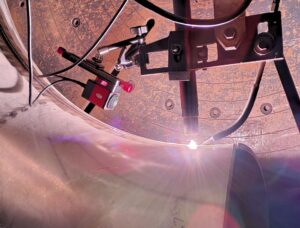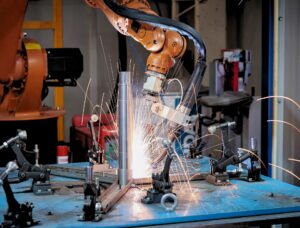In aerospace manufacturing, welding quality isn’t just about meeting specifications—it’s about ensuring the safety of human lives and the success of missions worth billions of dollars. Advanced inspection cameras have evolved from helpful tools to mission-critical components of aerospace quality assurance, enabling manufacturers to meet increasingly stringent standards while maintaining production efficiency. In this blog, we’ll explore how aerospace welding standards have driven the evolution of inspection technology from optional enhancement to mission-critical necessity.
The Unforgiving Nature of Aerospace Welding Standards
Aerospace welding operates under some of the most demanding quality requirements in manufacturing. Standards such as AWS D17.1 (Specification for Fusion Welding for Aerospace Applications) and various military specifications leave no room for compromise.
Zero-Defect Requirements: Unlike many industrial applications where minor defects might be acceptable, aerospace welding demands perfection. A single porosity bubble or incomplete fusion can lead to catastrophic failure at altitude or in space.
Material Challenges: Aerospace components often use exotic materials like titanium, inconel, and advanced aluminum alloys. These materials have unique welding characteristics that require precise monitoring to ensure proper fusion and avoid defects.
Complex Geometries: Aerospace components frequently feature intricate designs with varying thicknesses, tight access areas, and complex joint configurations that challenge traditional inspection methods.
Traceability Requirements: Every weld must be documented with complete traceability, including process parameters, environmental conditions, and visual evidence of quality.
Critical Defects That Cameras Must Detect
Advanced inspection cameras in aerospace applications must identify defects that could compromise structural integrity:
Lack of Fusion: Incomplete bonding between weld metal and base material, often invisible to the naked eye during welding but detectable through careful monitoring of weld pool behavior.
Porosity: Gas bubbles trapped in the weld metal that can initiate crack propagation under cyclic loading conditions common in aerospace applications.
Cracks: Both hot cracks (occurring during solidification) and cold cracks (developing after cooling) that can propagate catastrophically under stress.
Undercut: Grooves that create stress concentrations and reduce the effective cross-sectional area of the joint.
Incomplete Penetration: Insufficient weld depth that fails to achieve the designed joint strength.
Real-Time Detection Capabilities
Modern aerospace welding cameras provide unprecedented visibility into the welding process:
High-Resolution Imaging: Cameras capable of 4K or higher resolution reveal minute details in weld pool behavior that indicate developing problems.
Multi-Spectral Analysis: Different wavelengths reveal different aspects of the welding process, from surface oxidation to penetration depth.
Thermal Imaging Integration: Combines visible light imaging with thermal analysis to monitor heat distribution and cooling rates.
High-Speed Capture: Frame rates exceeding 1000 fps capture rapid phenomena like spatter ejection patterns that indicate process instability.
Compliance with Aerospace Standards
Advanced camera systems help manufacturers comply with critical aerospace standards:
AS9100 Quality Management: Camera systems provide the documentation and process control required for AS9100 certification.
NADCAP Accreditation: The National Aerospace and Defense Contractors Accreditation Program recognizes facilities with advanced monitoring capabilities.
Customer-Specific Requirements: Major aerospace OEMs increasingly require real-time monitoring for critical components.
Case Study: Critical Engine Component Manufacturing
A leading aerospace engine manufacturer implemented advanced welding cameras for turbine blade root welding. The results demonstrate the mission-critical nature of this technology:
Challenge: Traditional post-weld inspection missed subtle defects that led to field failures costing millions in warranty claims and grounding incidents.
Solution: Real-time camera monitoring with AI-powered defect detection algorithms that learned to recognize the subtle indicators of developing problems.
Results:
Improved customer confidence and contract renewals
95% reduction in field failures related to welding defects
60% reduction in inspection time
Complete traceability for every weld
Integration with Aerospace Manufacturing Systems
Modern aerospace welding cameras integrate seamlessly with existing manufacturing infrastructure:
ERP System Integration: Weld quality data flows directly into enterprise resource planning systems for complete traceability.
Statistical Process Control: Real-time data enables sophisticated SPC analysis to identify process drift before defects occur.
Digital Twin Compatibility: Weld monitoring data contributes to digital twin models that predict component performance over its service life.
Automated Reporting: Systems generate compliance reports automatically, reducing administrative burden and ensuring consistency.
Emerging Technologies in Aerospace Welding Monitoring
The future of aerospace welding inspection includes several promising technologies:
Machine Learning Enhancement: AI systems that continuously improve their defect detection capabilities based on field experience and failure analysis.
Augmented Reality Integration: AR systems that overlay real-time weld quality data onto the operator’s view for enhanced decision-making.
Predictive Analytics: Systems that predict when welding parameters will drift out of specification, enabling proactive adjustments.
Blockchain Documentation: Immutable records of weld quality data for enhanced traceability and fraud prevention.
ROI Considerations for Aerospace Applications
While advanced camera systems represent a significant investment, the aerospace industry’s unique cost structure makes them highly cost-effective:
Failure Cost Avoidance: A single field failure can cost millions in direct costs and immeasurable reputation damage. Preventing even one failure typically justifies the entire system investment.
Inspection Efficiency: Reduced manual inspection requirements free up skilled inspectors for other critical tasks.
Cycle Time Reduction: Real-time quality assurance eliminates the delay between welding and inspection, accelerating production schedules.
Customer Satisfaction: Enhanced quality and documentation capabilities strengthen customer relationships and support contract renewals.
Implementation Strategies
Successful deployment of advanced welding cameras in aerospace manufacturing requires:
Vendor Partnership: Work closely with camera system suppliers who understand aerospace requirements
Phased Implementation: Start with the most critical applications and expand gradually
Operator Training: Invest heavily in training programs to maximize system effectiveness
Process Standardization: Establish consistent procedures that enable accurate monitoring
Continuous Improvement: Regular analysis of monitoring data to refine detection algorithms
Conclusion
In aerospace manufacturing, advanced inspection cameras have transitioned from luxury to necessity. As quality requirements continue to tighten and consequences of failure remain severe, these systems provide the visibility and documentation needed to maintain the highest standards of safety and reliability.
The investment in advanced welding monitoring technology is not just about meeting today’s requirements—it’s about positioning for future success in an industry where quality is literally a matter of life and death.
Ready to upgrade your welding quality control? Contact Mecaweld today to learn how our weld monitoring cameras and inspection systems help you catch problems before the arc strikes.



